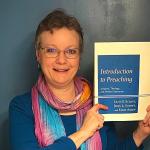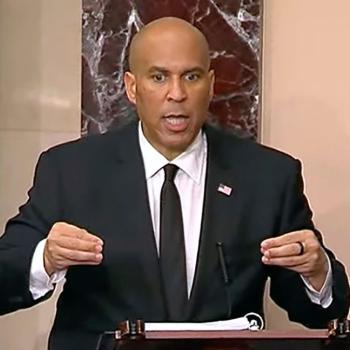It’s bad theology to believe the U.S. flag has a place in a worship space. Here’s a sermon to challenge that Christian Nationalist assumption.

For this blog series on countering Christian Nationalism during patriotic holidays, the sermon “A Dollar Sign, Cell Phone, and U.S. Flag Walk into a Church” is part two of four. [Links for the other parts of this series are at the end of this piece.]
This is an excerpt from Chapter 21 of the preaching textbook, Introduction to Preaching: Scripture, Theology, and Sermon Preparation, which I co-wrote with Jerry Sumney and Emily Askew.
Preaching context
Let’s imagine a situation where the pastor has had some initial conversations with church members about the appropriateness of the U.S. flag in the worship space but has encountered resistance.
Some have insisted that removing the flag would be disrespectful of veterans. Others have made the argument that the flag symbolizes the freedom for Americans to worship as they wish. As such, they argue, having the flag in the sanctuary is an important reminder of the source of this right. Further, they insist that honor is due the U.S. flag because of the protection the state provides the church, enabling it to be able exist in the first place.
Of course, this rationale overlooks or ignores who truly enables the church – and the state – to exist: God. Thus, this kind of thinking is undergirded by bad theology in need of correction.
The preacher will need a strategic approach to challenge the assumption that there is no competition between the flag and Christian symbols because they can coexist in harmony and symbiosis.
So, for this sermon on Exodus 20:1-6, I would use the Motion Pictures sermon form developed by homiletician David Buttrick.
The “motion pictures” sermon form
In his book Homiletic: Moves and Structures, Buttrick used the analogy of a photographer or cinematographer framing a succession of images that, ideally, creates a complete experience of understanding. He called each frame a “move” in which the preacher follows a precise sequence to enable listeners to focus on an idea and then move onto the next. With an introduction and conclusion on either end, there are typically three or four “moves” with an internal sequence as follows:
- Opening statement that contains the main idea.
- Development through illustration, clarification, antithesis, or elaboration.
- Closure with a restatement of the main idea.
The key to using this form is to use what I call a “hinge” that opens and closes each section so that the listener is clued into the sequence of ideas. The outline for a sermon using the Motion Pictures form, then, would look like this:
- Introduction; HINGE
- Move 1 (opening statement, development, restatement); HINGE
- Move 2; HINGE
- Move 3; HINGE
- Conclusion
Using the Motion Pictures form for a sermon addressing the presence of the U.S. flag in the church sanctuary, I would tell the story of the time I taught a lesson to Confirmation students on the Ten Commandments. (In the Lutheran denomination where I’m ordained, teens who were baptized as infants take part in Confirmation classes that culminate in an Affirmation of Baptism ritual.) I would use each of the “moves” in the sermon to describe a thought experiment I did with the class where they debated the appropriateness of certain symbols in the worship space.
Exodus 20:1-6
Then God spoke all these words:
2I am the Lord your God, who brought you out of the land of Egypt, out of the house of slavery; 3you shall have no other gods before me.
4You shall not make for yourself an idol, whether in the form of anything that is in heaven above, or that is on the earth beneath, or that is in the water under the earth. 5You shall not bow down to them or worship them; for I the Lord your God am a jealous God, punishing children for the iniquity of parents, to the third and the fourth generation of those who reject me, 6but showing steadfast love to the thousandth generation of those who love me and keep my commandments.
Central Question, Central Claim, Central Purpose
Introduction to Preaching uses a method of sermon preparation I developed called the Central Question, Central Claim, and Central Purpose. Here are the Central Statements for a sermon on Exodus 20:1-6.
Central Question
What does it mean to worship the God of Israel in a culture that deifies its national identity, and how will the church witness to the God of liberation in this community?
Central Claim
Because the God of Israel commanded believers to have no other gods, our congregation must engage in a serious discussion about the appropriateness of having the American flag, an engraved image of nationalism, within our worship space.
Central Purpose
The Central Purpose of this sermon is to compel the congregation to confront nationalism, name it as idolatry, and worship only the God of liberation.

“A Dollar Sign, Cell Phone, and U.S. Flag Walk into a Church…”
Note that this is not a full sermon but a description of the sermon trajectory using the Motion Pictures form.
Introduction
I would begin by describing the scene of the Confirmation students discussing the First Commandment to worship no other gods nor create any images of these idols. I brought a stack of magazines to the class and invited them to cut out pictures symbolizing the “gods” that people worship today.
Then we imagined what it would be like to see these different symbols in the sanctuary. I reminded them about the connection between the first commandment and the first article of the Apostle’s Creed, “I believe in God the Father Almighty, creator of heaven and earth.” Then I invited them into a thought experiment to substitute some of the images they have identified.
“I believe in _____ the Almighty, creator of heaven and earth” becomes the “hinge” for the moves of the sermon.
Move 1
Someone cut out a picture of a dollar sign.
“I believe in Money the Almighty, creator of heaven and earth.”
We discussed a series of questions. How is money like a god? Does it provide for us? Does it create things? Does it seem to be everywhere? Does it hurt us? Does it care about us?
Through thesis and antithesis, the students concluded that a dollar sign in the sanctuary would not be appropriate because it would be idolatry.
Move 2
Two students cut out pictures of cell phones and the wi-fi symbol for the internet.
“I believe in Internet the Almighty, creator of heaven and earth.”
With both humor as well as philosophical engagement, the students again worked through the series of question. How is cyberspace like a god? Does it provide for us? Does it create things? And so on.
Again, the students concluded that the symbol of the internet in the sanctuary would also be idolatry.
Move 3
One student cut out a picture of the Earth.
“I believe in Earth the Almighty, creator of . . .”
This one is trickier. Earth is actually mentioned in the first article of the Apostle’s Creed. The discussion became more somber as the students discussed the need to honor and take care of God’s Earth, and how humans were dishonoring God by polluting the Earth. But they concluded that Earth shouldn’t be worshipped in and of itself.
One astute student noted, however, that Gaia was worshiped as a goddess in ancient Greek mythology. Though they thought Earth should not be seen as a symbol of a deity, the group suggested that having a picture of the Earth in the worship space would be appropriate for an Earth Day worship service.
Move 4
The last image we discussed was the U.S. flag. “I believe in America the Almighty, creator of heaven and earth.”
The room got very quiet. One student pointed out the obvious: there IS a U.S. flag in the sanctuary.
We went through the questions. How is America like a god? Does it provide for us? Does it create things? Does America seem to be everywhere? Does it hurt certain people? Does it care about us? After much discussion (which mirrors what the adults have been discussing in other forums), the students were divided as to whether the flag should be in the sanctuary.
Conclusion
I would bring the sermon to a close by reminding listeners that in ancient Egypt, Pharaoh forced the Israelites to be subservient to all of the idols and to himself, claiming to be divine. Pharaoh made the same arguments that any country could make about its benevolence, ubiquity, and omnipresence. But his power ultimately rested on violence and control.
We may be divided on whether the flag belongs in the sanctuary, but our creed is clear: “I believe in God the Father Almighty, creator of heaven and earth.”
And our scripture is clear: God would not approve of having the flag in the worship space. Our desire to have it there is something we can discuss. But God is unequivocal that idolatry and graven images are unacceptable in the worship space. I would conclude by re-reading Exodus 20:1-6 and let that be the last word of the sermon.
Reflecting on the strategy of this sermon
In this sermon on the U.S. flag in the sanctuary, the congregation is compelled to grapple with the issue of nationalism but it happens vicariously through listening to the description of the students’ discussion (likely with chuckles at the silliness of certain images in the worship space). The congregation is a step removed because it is a story about others’ discussion about the flag in church. This allows them to observe the discussion without having to feel like they are debating the pastor or each other on the issue.
Incidentally, this sermon on the U.S. flag in the sanctuary used inductive logic because the Central Claim did not make its presence known until the conclusion of the sermon. I began with a series of clues in each move building toward the claim at the end. By this point, the congregation is invested in the story. They’re drawn in by the discussion of the youth and feeling the tension between what they want (flag in the worship space) and what God wants (no graven images). Concluding with a reiteration of the first commandment seals the sermon.
Stay tuned for parts three and four in this series coming at the end of June!
More information about countering Christian Nationalism
Faithful America has launched a sermon and prayer drive for Sunday, June 11, 2023 — the week of Flag Day — to bear witness for peace and love against Christian Nationalism.
They have put together a very helpful collection of preaching resources and sample prayers as part of a toolkit to equip clergy and congregations to counter the toxic effects of Christian Nationalism. These resources work well in the lead up to Flag Day, as well as for the week of Independence Day. To access the toolkit, sign up here.
Read the other sermons in this series exploring flag placement in the church through preaching:
Flagging the Flag – Idolatry and Freedom: Preaching Exodus 20:1-6
This Flag Has Legs: A Sermon Inviting Dialogue about Flag Placement in Church
The Big Red, White, and Blue in the Room: A Sermon about Deliberating the Flag in Church
Read also:
Flag Placement in Church: How to Have the Conversation

The Rev. Dr. Leah D. Schade is the Associate Professor of Preaching and Worship at Lexington Theological Seminary in Kentucky and ordained in the ELCA. Dr. Schade does not speak for LTS or the ELCA; her opinions are her own. She is the author of Preaching in the Purple Zone: Ministry in the Red-Blue Divide (Rowman & Littlefield, 2019) and Creation-Crisis Preaching: Ecology, Theology, and the Pulpit (Chalice Press, 2015). She is the co-editor of Rooted and Rising: Voices of Courage in a Time of Climate Crisis (Rowman & Littlefield, 2019). Her newest book is Introduction to Preaching: Scripture, Theology, and Sermon Preparation, co-authored with Jerry L. Sumney and Emily Askew (Rowman & Littlefield, 2023).













